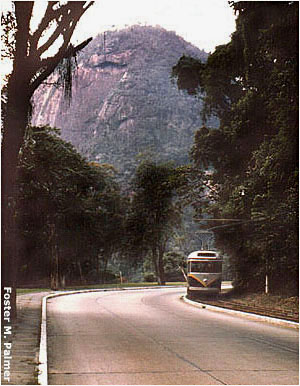The World's Most Beautiful Tramway Line
Rio de Janeiro, Brazil
Text by Allen
Morrison
Illustrations from his
collection
It might be, if it
were still running.
The world abounds in beautiful tram lines,
including The
Santa Teresa Tramway and the
Corcovado
rack railway, which
still run in Rio today.
The Alto da Boa Vista line has disappeared
but is recalled for its beauty and historical importance.
It was the first electric railway built in Latin America
and was one of the last to close.
Since the 1860s attempts
had been made
to scale the mountains around Rio de Janeiro
with cog railways, funiculars and aerial tram lines.
In 1870 a steam railroad was proposed
from the end of a horse tramway in Tijuca
(which was Brazil's first tram line, opened 1859)
to a park at altitude 385 meters / 1,263 feet
called Alto da Boa Vista ("Fineview Heights").
It was not built, but in 1890 another company
secured a franchise to build an electric line along
the same path and erected its "usina" (power plant)
on Rio Maracanã at the end of Rua Conde de Bonfim.
Today the power plant is gone, but this section of Rio
is still called Usina. The postcard below shows
the "usina" about 1892. Note the tram. (col. AM)
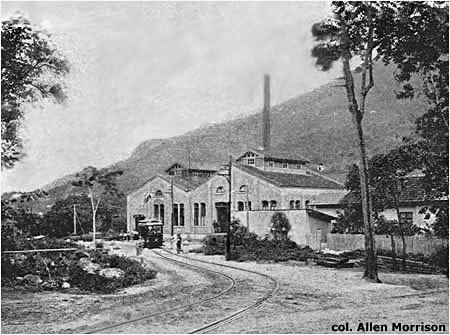
The Companhia Estrada de
Ferro da Tijuca
installed track and wire along a winding 5 km route
from Usina to Alto da Boa Vista and ordered
12 trolley cars from the John Stephenson Company
in New York, which arrived in Rio in 1891.
But CEFT ran out of money,
encountered engineering problems on the steep grade
and stopped construction for seven years.
The photograph below was taken when operation
of the line finally began in 1898.
(col. A. Spinelli)
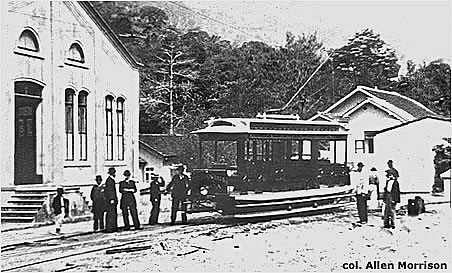
Photograph of another
Stephenson car,
similar to the model that the New Yorkers built at the
same time for Rio's Jardim Botânico tramway company,
which began construction later but opened in 1892
and was first on the continent to operate an electric line.
Note inscription "COMPANHIA E. DE F. DA TIJUCA"
on the back panel. (col. A. Spinelli)
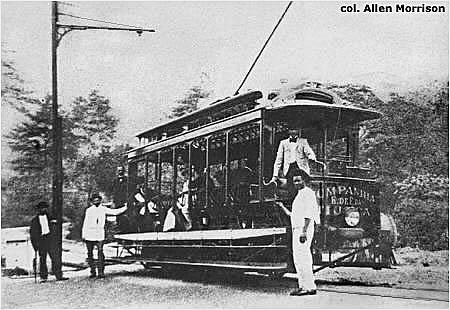
A rare view of a Stephenson
tram
on the top of the mountain,
at Alto da Boa Vista terminus, about 1905.
Today this spot is called Praça Afonso Viseu.
In 1903 the CEFT was sold to the São
Cristóvão
tramway company which painted the cars yellow.
(postcard, col. AM)
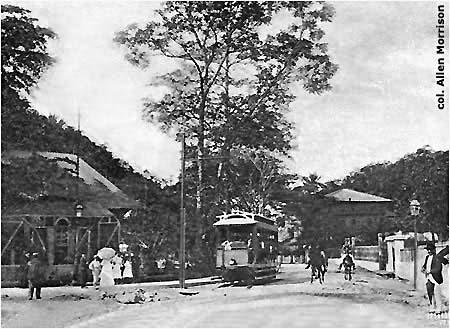
Riding an open tram up the
mountain
to the cooler climes of Alto da Boa Vista
was a favorite pasttime of Cariocas and the tourists
that visited Rio de Janeiro during the next 60 years.
An 8-wheel car waits at a passing siding in 1957.
Tram 1794 operates today on the
Main Street Trolley in Memphis, Tennessee.
(W. C. Janssen)
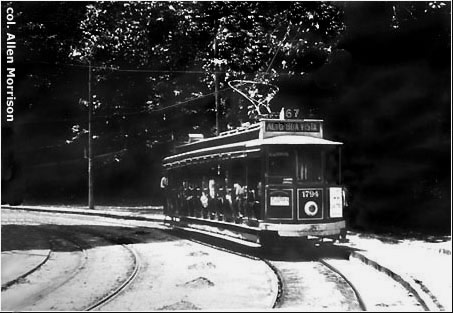
Most of Rio's tramways were
gone by 1960.
To celebrate the city's 400th anniversary in 1965,
the Companhia de Transportes Coletivos,
the new state transport board, rebuilt 10 open trams
as streamlined closed models, numbered 01-10,
for a special service on the Alto da Boa Vista line
which it hoped would appeal to tourists.
The vehicles were single-end and ran only one way,
so required the construction of turning loops.
Car 06 approaches Usina on 16 June 1965.
(This and the following five color photographs
were taken between 13 and 17 June 1965
by Massachusetts tramfan Foster M. Palmer.)
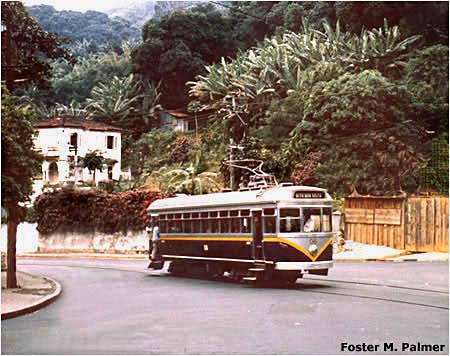
From Usina the tramway
began its spectacular climb
along Avenida Edson Passos (formerly Avenida Tijuca)
and the Estrada Nova da Tijuca (the original road).
The 5 km line was entirely single track with sidings.
A Beetle overtakes 01 on a curve. (Foster M. Palmer)
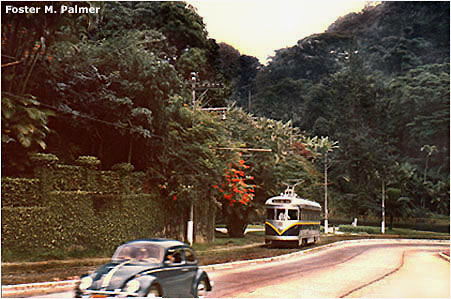
Higher and higher the rails
reached
into the Carioca Mountains.
There were steep grades and many S-curves.
Car 05 was going away from the camera.
(Foster M. Palmer)
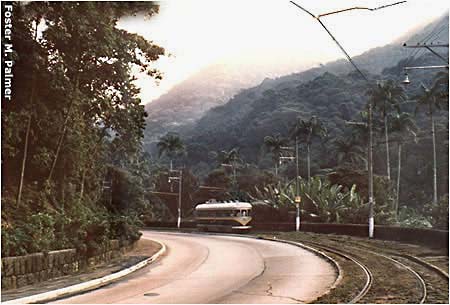
|
|
|
|
|
About
|
|
|
|
|
|
Alto da Boa Vista
terminus in 1965. The new tramway loop was on |
The Alto da Boa Vista
tramway was damaged by a storm
in January 1966 and shut down for four months.
As other tram depots in the city were closed,
a new garage for ABV cars was built behind the loop
shown in the last photograph and the line was
restored to its final form on Christmas Day 1966:
trams ran only from Usina up the mountain to Alto da Boa Vista
- an isolated, independent tramway in the suburbs -
exactly what the E. de F. da Tijuca had established in 1891!
Another storm in January 1967 closed the line again.
It reopened in March, struggled with two cars for
several months, closed, reopened, ran intermittently,
and was finally declared permanently abandoned
on 21 December 1967.
Buses served the same route and new districts beyond;
tourists resisted a long bus ride to Usina
for a tram that might not run, and in any case
wanted to ride on an open tram, not a closed one.
In January 1968 the rails along the route
were removed and the trams were destroyed.
This was the last standard-gauge tramway line
in Rio de Janeiro.
The narrow-gauge (1100 mm) Santa
Teresa Tramway
still runs in that city today.
If you have more illustrations
or information
about the Alto da Boa Vista tramway
- especially photographs from its early years -
please
contact the author!
If you want to know more about the tramways of Brazil
see the text of my book, The
Tramways of Brazil.
Also see my general inventory of
ELECTRIC
TRANSPORT IN LATIN AMERICA.
This page was created
by Allen Morrison
on 9 July 1999.
www.tramz.com/br/rj/ab/v.html
Copyright © 1999-2099 Allen Morrison - ALL RIGHTS RESERVED
